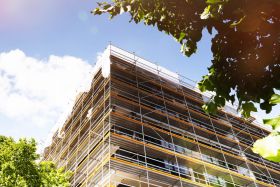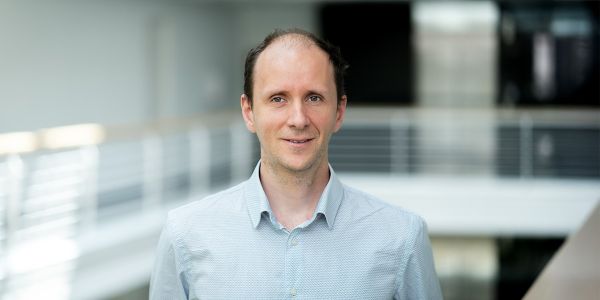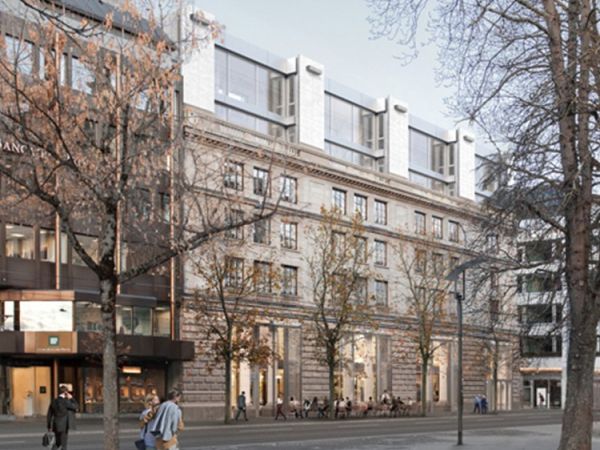
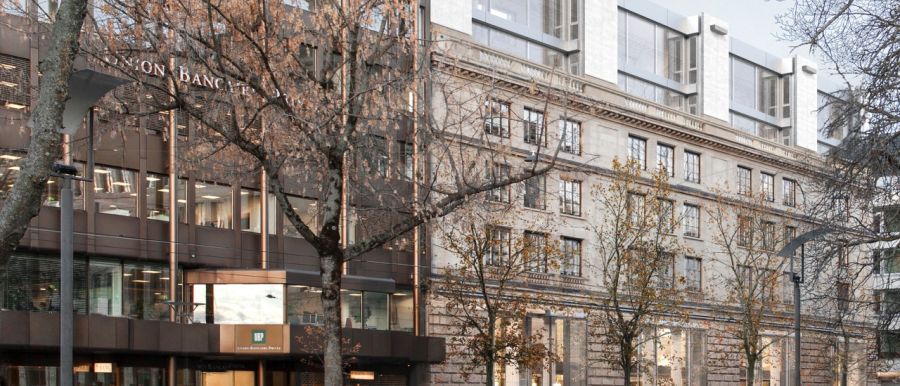
- 215 MWh heat requirement
- 109 MWh cooling requirement
- 100 per cent carbon-free
- 32 kWp PV output
Zurich’s Bahnhofstrasse is probably the best-known shopping area in Switzerland. For most passers-by, however, it ends at Paradeplatz. The few hundred metres to the lake are – with a few exceptions – a no man’s land in terms of shopping. That’s all about to change. The office building at Bahnhofstrasse 3 will reopen at the end of 2024 following a complete overhaul. Based on the original building, erected in 1880 by Gottfried Semper student Albert Müller, and continuing on from the first major renovation in 1930, the Zurich-based architecture firm Studio Märkli has developed a concept that will transform the building to meet today’s needs. At the same time, the building owner, Genossenschaft zum Baugarten, wants to fully exploit the potential in terms of urban development and strengthen and revitalise upper Bahnhofstrasse by adding an architectural highlight. The new building, with its historical appearance, will offer great flexibility of use and is being created in accordance with the requirements imposed by its listed status.
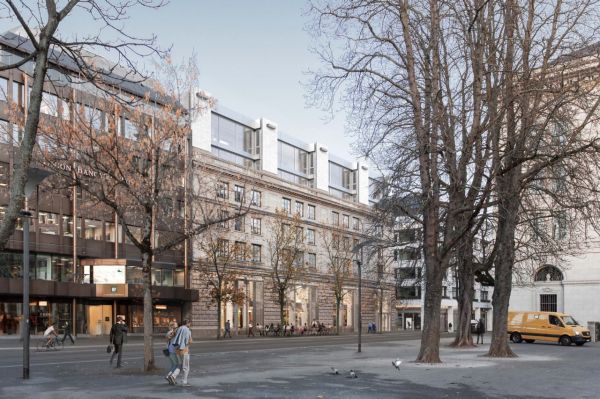
Modern technology
The transformation is particularly visible from the inside. Based on comprehensive analysis, the planners quickly determined that the interior of the building, which had been converted several times and fitted with false ceilings, would be unable to meet the requirements of state-of-the-art building technology and high levels of user comfort. The existing building was fully gutted to create space for a modern interior.
The listed facade remains largely intact, with only spot changes being made. At the same time, the building will be expanded by adding two attic floors with a green roof terrace. The aim of this profile adjustment is to harmonise the historical building, which originally housed the first Swiss stock exchange, with neighbouring properties. To open up the space towards Bahnhofstrasse, the ground floor will be lowered to street level and upgraded with inviting entrance areas and shop windows. The lower floors will house the fashion shop Grieder. The upper floors will be used as office space by the American investment bank Goldman Sachs.
Unique in Europe
The Genossenschaft zum Baugarten attaches great importance to the environment. The building is therefore going to be certified according to the US LEED building label. To ensure an environmentally friendly working environment, the building will also meet numerous Minergie Eco standards. The client also wanted a fossil-free heating and cooling system. We developed an innovative, fossil-free energy supply concept, with the aim of providing users with a high level of comfort and a pleasant indoor climate. The planning team was helped in this by the location: ‘Due to the close proximity of the lake basin, the use of lake water for both heating and cooling was an obvious choice,’ explains our project manager David Füllemann. According to Ron Stelzig from Fanzun AG, which is acting as the client’s representative for the Baugarten project, geothermal probes were also considered initially. Due to the high investment costs on the part of the client and the possible risks resulting from the very deep drilling on a difficult building site, the idea was dropped.
Pushed, not sucked
However, before Bahnhofstrasse 3 could become part of the Fraumünster lake heat network, which had been in existence since 2003, the network had to be expanded. The planned expansion of the supply area also increased the volume of water that had to be transported from the 15 metre deep catchment to the energy centres. As this exceeded the capacity of the existing pumps, ewz developed a solution that is unique in Europe: instead of sucking in the lake water using pumps on land as we normally do, we ‘push’ it to the energy centres via submersible pumps placed in the lake basin. The advantage of this is that losses in efficiency can largely be avoided. ‘The new pump platform installed in the lake basin in February 2022 has enabled us to double the capacity of the Fraumünster lake heat network’, explains Füllemann. When completed, it will provide heating and cooling to three other buildings in the district around Paradeplatz, in addition to Bahnhofstrasse.
Environmentally friendly free cooling
In the energy centre, which is located in the building, the water passes through a filter to clear it of any shells. The energy exchange with the secondary circuit takes place via a heat exchanger. A heat pump brings the water to the desired temperature and distributes it to the individual floors. Free cooling is mostly used for cooling where lake water is used directly (without the use of cooling machines). This is an extremely eco-friendly and economical alternative to air conditioning systems that use large amounts of energy. The cold generated in winter as a result of heat production can largely be used in the building, for example to cool server rooms. We use the waste heat from the servers for producing hot water, amongst other things.
Solar power for heat pumps
Our contract also includes the photovoltaic system on the roof of the property. A contract concluded with the client states that the Genossenschaft zum Baugarten co-operative society must make the roof area available, and that ewz is to implement the installation and is entitled to use the electricity produced. Most of the solar power will be used to operate the heat pump. If the volume produced is insufficient, we will draw renewable electricity from the grid.
Forward-looking planning
Bahnhofstrasse 3 will be one of the first properties to be integrated into the planned CoolCity network (Lake Zurich lake heat network) – provided that Zurich’s City Parliament and voters give the go-ahead for the building work, which will provide buildings in Zurich’s city centre with heating and cooling in the future. If everything goes according to plan, this should be the case between 2028 and 2030. Additional properties will be added at a later date.
According to Füllemann, the transition from Fraumünster to CoolCity is a good thing: ‘As this will be the first property to be part of CoolCity one day, we have to start thinking about the future integration. At the same time, it’s important that we don’t block anything for the future,’ explains Füllemann.
Efficient, fossil-free, reliable
This efficient type of heating and cooling enables us to offer a 100 per cent fossil-free energy solution. For the client, the contract with a term of 30 years not only makes ecological and economical sense, it also offers advantages in terms of convenience: ‘ewz is a great partner for us and delivers reliable fossil-free energy at all times’, says Stelzig. The client bears no risk, as the energy service provider ensures not only the financing through a service contract, but also the maintenance and smooth operation of the energy supply. If the system should however fail, redundancies are available. ‘For the owners, this is the ideal all-inclusive package,’ says Stelzig.
